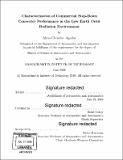Characterization of commercial step-down converter performance in the low Earth orbit radiation environment
Author(s)
Aguilar, Alexa Christine.
Download1119723027-MIT.pdf (11.48Mb)
Other Contributors
Massachusetts Institute of Technology. Department of Aeronautics and Astronautics.
Advisor
Kerri Cahoy.
Terms of use
Metadata
Show full item recordAbstract
We characterize three commercial step-down DC-DC converters for the Low Earth Orbit (LEO) space radiation environment. Commercial space industry is shifting spacecraft design philosophy toward accepting more risk for shorter lead times, lower costs, and high instrument performance. This shift opens up the Commercial Off The Shelf (COTS) electronics market to space applications. To quantify the risks associated with using COTS parts, components must be tested in flight-like configurations and conditions and their response to environmental stresses characterized. Few data exist in literature on the performance of DC-DC converters in the space radiation environment despite their ubiquity in designs and key role in operation for which the alternative is prohibitively expensive. This thesis introduces the space radiation environment and resulting effects. We then model the environment for two LEO constellation configurations and determine the maximum expected radiation levels over the mission lifetime. These levels are then used to inform radiation tests. The DC-DC converters are Total Ionizing Dose (TID) and Single Event Effects (SEE) tested in radiation conditions representative of the LEO space radiation environment. These devices demonstrate radiation tolerance in both tests, with a minimum TID tolerance of 60 krad(Si) and experience no destructive latch-up behavior to about 90 MeV-cm²-mg⁻¹. A first order reliability analysis shows these parts introduce little additive risk to spacecraft design.
Description
Thesis: S.M., Massachusetts Institute of Technology, Department of Aeronautics and Astronautics, 2019 Cataloged from PDF version of thesis. Includes bibliographical references (pages 87-95).
Date issued
2019Department
Massachusetts Institute of Technology. Department of Aeronautics and AstronauticsPublisher
Massachusetts Institute of Technology
Keywords
Aeronautics and Astronautics.